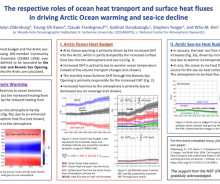The respective roles of ocean heat transport and surface heat fluxes in driving Arctic Ocean warming and sea-ice decline
Young-Oh
Kwon
Woods Hole Oceanographic Institution
Poster
Arctic Ocean warming and sea-ice loss are closely linked to increased ocean heat transport (OHT) into the Arctic and changes in surface heat fluxes. To quantitatively assess their respective roles, we use the 100-member Community Earth System Model Version 2 (CESM2) Large Ensemble over the 1920-2100 period. We first examine the Arctic Ocean warming in a heat budget framework by calculating the contributions from heat exchanges with atmosphere and sea-ice and OHT across the Arctic Ocean gateways. Then we quantify how much anomalous heat from the ocean directly translates to sea-ice loss and how much is lost to the atmosphere. We find that Arctic Ocean warming is driven primarily by increased OHT through the Barents Sea Opening, with additional contributions from the Fram Strait and Bering Strait OHTs. These OHT changes are driven mainly by warmer inflowing water rather than changes in volume transports across the gateways. The Arctic Ocean warming driven by OHT is partially damped by increased heat loss through the sea surface. The increased heat loss to atmosphere is concentrated in the cold season, thus enhances the seasonal cycle of the ocean-atmosphere heat exchanges. We also explicitly calculate the contributions of ocean-ice and atmosphere-ice heat fluxes to sea-ice heat budget changes. Throughout the entire 20th century as well as the early 21st century, the atmosphere is the main contributor to ice heat gain in summer, though the ocean’s role is not negligible. Over time, the ocean progressively becomes the main heat source for the ice as the ocean warms.

kwon-young-oh-polar-poster.pdf
(611.31 KB)
